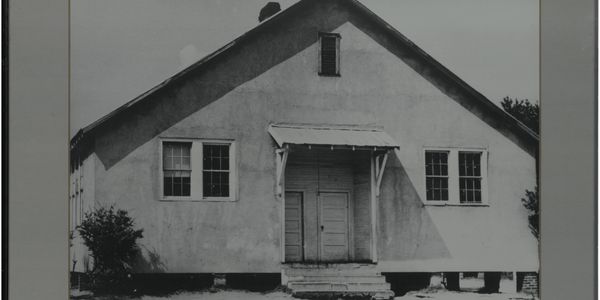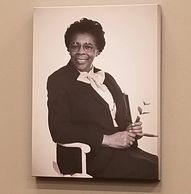Harlem, Georgia Exhibits
Firsts in Georgia and Columbia, County
Firsts in Georgia and Columbia, County
Firsts in Georgia and Columbia, County

Pollard Academy, one of the pre-Civil Rights Era Black American schools featured in our exhibition.
Harlem Businesses from 1870 until 1990
Firsts in Georgia and Columbia, County
Firsts in Georgia and Columbia, County

The exhibition shows previous businesses in Harlem.
Genesis of Harlem
Genesis of Harlem
Genesis of Harlem

North Louisville Street, Sylvan Georgia, 1842
Black American Schools: Pre-Civil Rights Era
During the early years of Harlem, segregation was the law. African American students were not allowed to attend school at the Academies (single building public schools for all grades). The Public school system did not make any arrangements for the learning of African American children. The Churches in the local area took it upon themselves to band together and provide an excellent education to our local black community. These schools were generally in one or two-room schoolhouses.
Tracy Luckey Pecans and Annual Festival
A set of three bulletin boards from Tracy-Luckey Pecans one of the businesses exhibited in the Harlem History Museum. Tracy Luckey was a major part of the Harlem economy beginning in 1892 as Lucky Lady Pecans. In 1937, Mr. Francis Williams Tracy took over the business from his parents, Arthur Tracy and Ruth Reveille Tracy, 1937, after a train accident that severely injured his father. Mr. Tracy had a childhood friend who was considered a people person. Both men were “smart as a whip.” They stayed friends their entire lives. In 1946 after WWII, Mr. Marion W. Luckey Sr. joined the business. The business was reincorporated as the Tracey Luckey Pecan Co. in 1950.
It was sold intact to San Saba Pecans in 2010. San Saba retrofitted the plant, making repairs that the past few years' financial difficulties had made impossible. San Saba kept the plant, warehouse, and store going until the summer of 2018. During that summer, San Saba Pecans shut down the Tracy Luckey plant, warehouse, and storefront in stages discontinuing the Lucky Lady Pecans line of Pecans. These changes laid off most of the workers. Many of those workers had to seek jobs elsewhere.
Civic Influences
Georgia Railroad was a significant part of Harlem from the founding through when both passenger and freight trains started passing through instead of stopping in Harlem. Today the train still passes through town at least once to twice per day.
Harlem Interactives

Comment Interactive
This interactive on the Harlem Museum side usually has a question that visitors can answer. It changes periodically so visit us to see new questions!
Exhibits
The Genesis of Harlem
Celebrating Our People
The Genesis of Harlem

Find out how and why Harlem was founded. We were incorporated as a city shortly after the Civil War. How we got our name is an interesting little story as well. Join us on a journey through time.
Harlem Did it First
Celebrating Our People
The Genesis of Harlem

As the first incorporated city in Columbia County, Georgia, Harlem was a trendsetter from its founding in 1872 through the early 20th Century.
Celebrating Our People
Celebrating Our People
Celebrating Our People

We celebrate our entire community and all of its accomplishments. We have many people from Harlem that have accomplished fantastic and marvelous things. We have one section dedicated to outstanding citizens that will rotate quarterly. Many people are recognized in their areas of expertise.
Sources used for our Exhibits
Primary Sources
Primary sources provide first-hand testimony or direct evidence concerning a topic under investigation. They are created by witnesses or recorders who experienced the events or conditions being documented. Often these sources are created at the time when the events or conditions are occurring, but primary sources can also include autobiographies, memoirs, and oral histories recorded later.
Newspaper Examples
Newspaper Clippings (unfortunately without dates or Newspaper Name)
The Augusta Chronicle
The Columbia County News Times
Northwest Evening Mail
The Augusta Herald
Columbia News Publishing
Correspondence Examples
1986 Bid from Culpepper Motor Company
1978 Letter by Mayor Clary calling for a Department Head Meeting
Other
*Oral History Interviews
Book Examples
"The Grand Lodge of Georgia Free and Accepted Masons 1786-1980." Macon, GA: The Masonic Home Print Shop, 1983.
"Proceedings of the Grand Lodge of Georgia." Macon, GA: The Masonic Home Print Shop, 1902." " Rosier, William Henry, and Fred Lamar Pearson, Jr.
"Tracy's Pecan Products, Inc. Harlem, Georgia," 30 Nov. 1953, Account Book
"Harlem, Georgia, Columbia County, Economic Summary," booklet, Sept. 1963
Secondary Sources
Secondary sources were created by someone who did not experience first-hand or participate in the events or conditions you’re researching. For a historical research project, secondary sources are generally scholarly books and articles. A secondary source interprets and analyzes primary sources. These sources are one or more steps removed from the event. Secondary sources may contain pictures, quotes or graphics of primary sources.
Book Examples
"History of the Harlem Women's Club" by Bette Sargent, 1996
Add a footnote if this applies to your business
